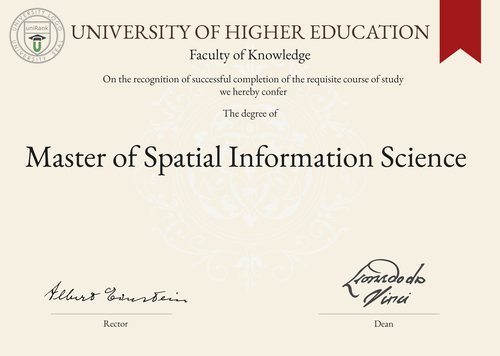
Master of Spatial Information Science (MSIS)
Guide to University Programs/Courses
Master of Spatial Information Science (MSIS)

Program/Course Name
Master of Spatial Information Science
Program/Course Abbreviation
MSIS
Duration Range
1-2 years
Tuition Range (US, UK, AUS, NZ)
$10,000-$50,000
Overview
The Master of Spatial Information Science degree is a postgraduate program that focuses on the study of geographic information systems (GIS), remote sensing and spatial analysis. This degree is designed to provide students with the skills and knowledge necessary to work in a variety of fields, including urban planning, environmental management and natural resource management.
Curriculum Overview by Year
- Year 1:
- Introduction to GIS
- Remote Sensing
- Geospatial Analysis
- Database Management
- Year 2:
- Advanced GIS
- Geospatial Modeling
- Web Mapping
- Capstone Project
Key Components
The key components of the Master of Spatial Information Science degree include the study of GIS, remote sensing and spatial analysis. Students will also learn about database management, geospatial modeling and web mapping. The program typically includes a capstone project that allows students to apply their knowledge to a real-world problem.
Career Prospects
Graduates of the Master of Spatial Information Science degree can pursue careers in a variety of fields, including urban planning, environmental management and natural resource management. They may work for government agencies, non-profit organizations, or private companies. Some common job titles include GIS analyst, remote sensing specialist and spatial data scientist.
Salary Expectations
The salary expectations for graduates of the Master of Spatial Information Science degree vary depending on the industry and location. According to Payscale, the average salary for a GIS analyst is $57,000 per year, while a remote sensing specialist can earn an average of $75,000 per year.
For a more accurate understanding of salary expectations, you can utilize the Job Sites Search Engine, from our sister site jobRank, which searches over 4,600 job sites worldwide. Make sure to specify not only the job title but also the country you are interested in.Conclusions
The Master of Spatial Information Science degree is a valuable postgraduate program that provides students with the skills and knowledge necessary to work in a variety of fields. However, it is important to note that the duration, tuition fees, curriculum, key components, career prospects and salary expectations can vary depending on the country and university where the degree is pursued. Visitors can search for where this specific degree is offered anywhere in the world through the uniRank World Universities Search Engine.
World Universities Search Engine
search for Master of Spatial Information Science (MSIS) and add the Location (country, state etc.) or specific University you are interested in studying at.
Query examples:
- Master of Spatial Information Science (MSIS) United States
- Master of Spatial Information Science (MSIS) United Kingdom online
- Master of Spatial Information Science (MSIS) Australia international students
- Master of Spatial Information Science (MSIS) University of California
- Master of Spatial Information Science (MSIS) University of London tuition fees
- Master of Spatial Information Science (MSIS) University of Sydney scholarships